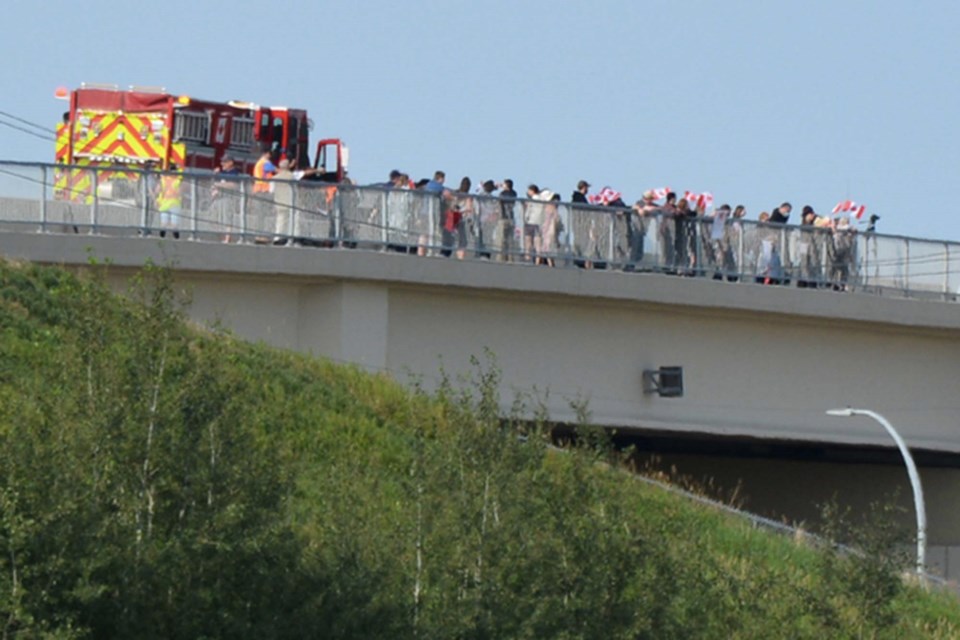There’s a sad but important military story from the war in Afghanistan that has yet to be told. Now, a new film in production throughout Edmonton and Sturgeon County will change all that.
Fallen Heroes: Their Journey Home offers the narrative of the ramp ceremony, the repatriation of a soldier who died while serving in a foreign land. When the plane lands, the ramp descends, and a military procession comes out with the coffins.
It’s an important aspect of the grieving process, offered writer/director Robert Curtin, but one that had to be fought for. The infamous friendly-fire incident of a misdirected U.S. bomb felled four soldiers from the Third Battalion of the Princess Patricia’s Canadian Light Infantry (PPCLI), wounding eight more, in Afghanistan on April 17, 2002. The commanders of the U.S. base in Kandahar did not easily accept the plan to have the ramp ceremony during the day – or at all.
“The Americans did repatriate their soldiers; however, that was done under the cover of darkness so nobody could see,” he explained.
“In fact, we had a case where, with our first Canadian soldiers back in 2002, we did have a newsman who was embedded doing both camera and recording. He actually took a shot outside the mortuary affairs building on KAF [Kandahar Air Field] of body bags with American soldiers in them. The American commander basically said to our commander, ‘Get him off my base now or I'll kill him myself.’ As you could imagine at that time, there was a lot of emotion. In fact, the Americans did not want the Canadians to hold a ceremony.”
He has teamed up with producer Karen Storwick to create Combined Forces Production, the company responsible for bringing Curtin’s script to the screen. The ceremonial procession was not part of the military’s plan of action, Storwick said, suggesting that how it came to be instituted is something all Canadians should learn.
“The thing that we learned at that time was that we'd never done ramp ceremonies before, because we had never repatriated our fallen. Our fallen from other wars were buried where they fell. When we went to Afghanistan as a military, we weren't prepared to lose people. We went to Afghanistan without transfer cases, which are the coffins,” said Storwick. “We just did not go to Afghanistan with the intent that we were going to lose somebody.”
Friendly-fire incidents do happen. Up until that time, peacekeeping missions had seen the military put into “many precarious positions,” but nothing quite prepared them for what happened in Afghanistan.
“We were there with the Americans on the Kandahar Air Field. It became clear that these guys wanted to say good-bye to their buddies,” Storwick said.
Warrant officer Jim Butters asked his American counterparts how they send fallen soldiers home. He was told they are sent back on a plane in the dead of night, Storwick said.
This wasn’t acceptable to him or the rest of the Canadian contingent. The answer was the ramp ceremony, which became akin to the funeral procession of a national leader. When those fallen soldiers returned to Canadian soil, the streets were lined with people waving flags and celebrating the soldiers’ service to the world.
In Sturgeon County last weekend, a crowd of volunteer extras lined the Veterans Boulevard overpass as a caravan of limousines and hearses drove down Highway 28 as part of one of the most dramatic scenes, recreating Toronto's Highway of Heroes scene along the 401. Farther north up the road, Namao School was used as a staging point for the crew and cast, and was set to be featured in two scenes of the movie.
Sturgeon Public Schools' communications advisor Karen Meurer said the school district was honoured to help out because basically every school in the 17-school district has a child from a military family, especially Namao School and Guthrie School on the base.
"When the production company wasn't actually able to use the base because of restrictions and COVID, they came location scouting and saw Namao School. They gave us a call and said, 'Would you be willing to let us use your school for the day as a staging point [and actually be in the movie for a couple of the scenes]?' We happily said, 'Yes,' because it's really near and dear to our hearts," Meurer said.
Curtin said COVID was a "huge hiccup," noting that it prevented them from filming on base due to federal health restrictions still in place. The reason Namao School was chosen was because their first choice – the Military Family Resource Centre – was still unavailable.
Movie productions are always about rolling film while rolling with the punches. The plan now is to get through the rest of their scenes on the base by the fall and have Fallen Heroes in the can shortly thereafter. There is still much to accomplish and many low-budget films rely on public goodwill and the generosity of strangers to keep things afloat.
“It's going to premiere, by hook or by crook, on April 17, 2022,” Curtin said, highlighting the 20th anniversary of the sad day in history.
After it arrives in theatres, the intention is to use the film for educational purposes in social studies classrooms across the country.




